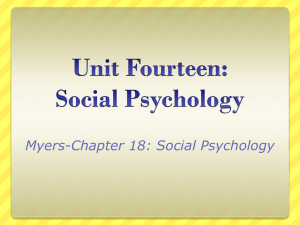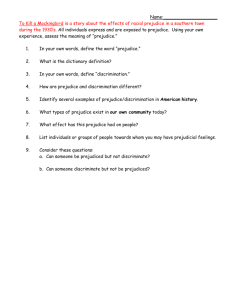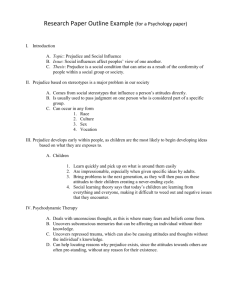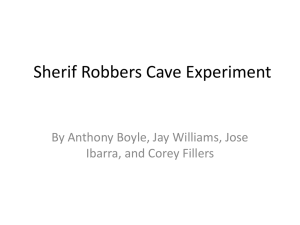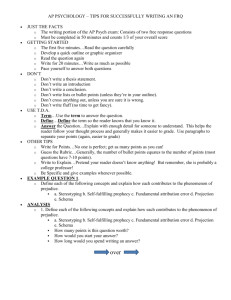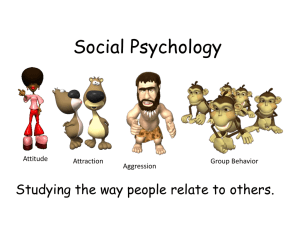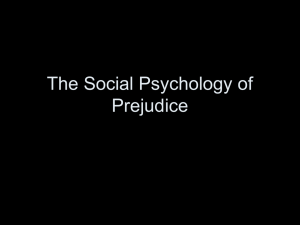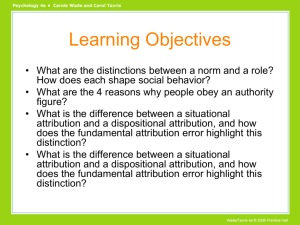Myers-Chapter 18: Social Psychology
advertisement
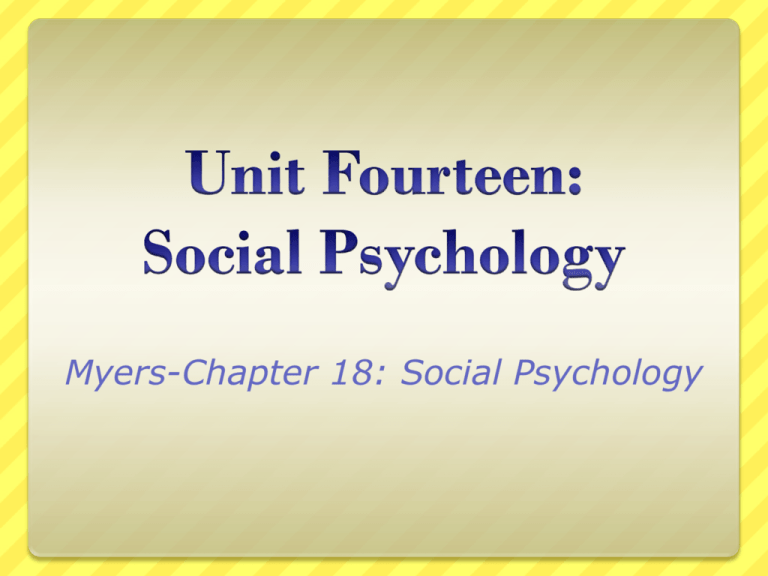
Myers-Chapter 18: Social Psychology "We cannot live for ourselves alone. Our lives are connected by a thousand invisible threads…” ~Herman Melville What is social psychology? the scientific study of how we think about, influence, and relate to one another attribution, actions and attitudes How do we explain others' behaviors? Fritz Heider (1896-1988) attribution theory- suggests how we explain someone‟s behavior, by crediting either the situation or the person‟s disposition fundamental attribution error-tendency to underestimate the impact of the situation and overestimate personal disposition How do you explain these situations? The Fundamental Attribution Error The observer: The violently destructive message that The Who and other rock groups deliver leaves me little surprised that they attract a mob that will trample human beings to death to gain better seats. Of greater concern is a respected news magazine’s adulation of this sick phemomenon. The actor: While standing in the crowd at Riverfront Coliseum, I distinctly remember feeling that I was being punished for being a rock fan. My sister and I joked about this, unaware of the horror happening around us. Later, those jokeds came back to us grimly as we watched the news. How many lives will be lost before the punitive and inhuman policy of festival seating at rock concerts is outlawed? Compared to people in Western countries, those in East Asian cultures are more sensitive to situational influences on behavior. TRUE Who is to blame? Husband Wife Lover #1 Lover #2 Ferryboat Captain Highwayman "Just-World Phenomenon" tendency of people to believe the world is just and that people therefore get what they deserve and deserve what they get attitude- feelings, often based on our beliefs, that predispose us to respond in a particular way to objects, people and events sometimes lead to but, more commonly… lead to In order to change people’s racist behaviors, we first need to change their racist attitudes. FALSE foot-in-the-door phenomenon the tendency for people who have first agreed to a small request to comply later with a larger one How does role-playing affect attitudes? Zimbardo‟s Stanford Prison Experiment “No man, for any considerable period, can wear one face to himself and another to the multitude without finally getting bewildered as to which may be true.” Nathaniel Hawthorne Why do we act this way? cognitive dissonance theory- theory that we act to reduce the discomfort (dissonance) we feel when two of our thoughts are inconsistent Prisoner's Dilemma Two burglars, Bob and Al, are captured near the scene of a burglary and are given the “third degree” separately by the police. Each has to choose whether or not to confess and implicate the other. If neither man confesses, then both will serve one year on a charge of carrying a concealed weapon. If each confesses and implicates the other, both will go to prison for 10 years. However, if one burglar confesses and implicates the other, and the other burglar does not confess, the one who has collaborated with the police will go free, while the other burglar will go to prison for 20 years on the maximum charge. What should they do? “Bonus Point Ballot” •If less than 4 people select 15 bonus points, those people will receive the 15 points and everyone else will receive 5 points. •If more than 4 people select 15 bonus points, no students will receive bonus points. •How many points would you like to receive? Choose one. 15 points 5 points conformity,obedience and group influence Behavior is contagious. chameleon effect- we unconsciously mimic others‟ expressions, postures, voice, tones, etc.; helps us feel what they are feeling Chimps are more likely to yawn after observing another chimp yawn. TRUE Solomon Asch and Conformity conformity- adjusting one‟s behavior or thinking to coincide with a group standard What conditions increase conformity? one feels incompetent or insecure group has at least 3 people group is unanimous one admires the status or attractiveness of the group one has no prior commitment to a response one„s behavior is observed by others culture encourages respect for social standards Why do we conform? to avoid rejection and/or to gain social approval; to gain information normative social influence- influence resulting from a person‟s desire to gain approval or avoid disapproval informational social influence- influence resulting from one‟s willingness to accept others‟ opinions about reality Stanley Milgram and Obedience to Authority How do people respond to commands? Stanley Milgram and Obedience to Authority Where would you stop? Slight Shock 15,30,45,60 Moderate Shock 75,90,105,120 Strong Shock 135,150,165,180 Very Strong Shock 195,210,225,240 Intense Shock 255,270,285,300 Extreme Intensity Shock 315,330,345,360 Danger: Severe Shock 375,390,405,420 XXX 435,450 When was obedience the greatest? the person giving the order was near in proximity and seemed a legitimate authority the person giving the order was affiliated with a prestigious institution the victim was far away or was depersonalized no other participants were seen disobeying What can we learn from these studies? The experiments of Asch and Milgram were devised to force participants to choose between following their own beliefs/standards and being responsive to the group. Strong social influences can make people conform. Most people would refuse to obey an authority figure who told them to hurt an innocent person. FALSE How do groups influence our behavior? social facilitation- stronger performance on simple or well-learned tasks in the presence of others social loafing- tendency for people in a group to exert less effort when pooling their efforts toward attaining a common goal than when individually accountable deindividuation- loss of self-awareness and self-restraint occurring in group situations that foster arousal and anonymity Studies of college and professional athletic events indicate that home teams win about 6 in 10 games. TRUE Sport Games Studied Home Team Winning % baseball 23,034 53.5% football 2,592 57.3% ice hockey 4,322 61.1% basketball 13,596 64.4% soccer 37,202 69.0% Individuals pull harder in a team tugof-war than when they pull in a oneon-one tug-of-war. FALSE How does interacting with others effect our behavior? group polarization- enhancement of a group‟s prevailing inclinations through discussion within the group groupthink- mode of thinking that occurs when the desire for harmony in a decision-making group overrides a realistic appraisal of alternatives The higher the morale and harmony of a social group, the more likely are its members to make a good decision. FALSE What can the individual do? minority influence- power of one or two individuals to sway majorities more likely when the minority opinion is held strong Never doubt that a small group of thoughtful, committed citizens can change the world. Indeed, it is the only thing that ever has. ~Margaret Mead (1901-1978) prejudice, aggression, conflict, attraction, altruism, & peacemaking Prejudice "prejudgment" unjustifiable (usually negative) attitude toward a group or members; generally involves stereotyped beliefs, negative feelings, predisposition to discriminatory action stereotype- generalized belief about a group of people; sometimes accurate, but often overgeneralized Prejudice vs. Discrimination prejudice is a negative attitude; discrimination is a negative behavior The how's and why's of prejudice… it seems racial and gender attitudes have changed overt prejudice has disappeared, but subtle prejudice remains recent experiments show prejudice can be automatic/unconscious social, emotional and cognitive roots of prejudice Social: prejudice rationalizes social inequalities us and them: ingroup bias Emotional: prejudice comes from “the passions of the heart” scapegoat theory: prejudice offers an outlet for anger by providing someone to blame Cognitive: categorization- a way to simplify the world just-world phenomenon and hindsight bias vivid cases stand out more readily Vivid Cases Islam Terrorism Aggression any physical or verbal behavior intended to hurt or destroy biological influences: genetic, neural and biochemical psychological influences: frustration-aggression principle, learning, observation It is difficult to change established aggressive behavior patterns. Those who keep a gun in the house are more likely to be murdered. TRUE Conflict perceived incompatibility of actions, goals, and ideas social traps- situation where conflicting parties, by each pursuing their self-interest, become caught in mutually destructive behaviors Prisoner’s Dilemma (individual self-interest vs. communal well-being) enemy perceptions Attraction Three ingredients: 1. proximity 2. physical attractiveness 3. similarity Proximity geographic nearness most powerful predictor of friendship mere exposure effect repeated exposure to novel stimuli increases our liking Physical Attractiveness this is what most affects first impressions judgment of attraction is relative, but some characteristics are universal attraction also depends on how we feel about a person “Do I love you because you’re beautiful, or are you beautiful, because I love you?” (Cinderella) “Love looks not with the eyes, but with the mind.” (A Midsummer Night‟s Dream) Which face do you find most attractive? D B A C Similarity "Opposites attract." “Birds of a feather, flock together.” 2 types of love 1. temporary passionate love 2. more enduring companionate love 2 keys to a satisfying and long-lasting relationship equity and self-disclosure Altruism unselfish regard for the welfare of others bystander effect- tendency for any given bystander to be less likely to give aid if other bystanders are present Why do we help people? social-exchange theory reciprocity norm social-responsibility norm Peacemaking Peacemaking is helped by cooperation, communication, and conciliation.
